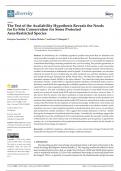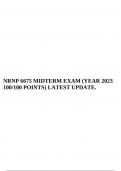diversity
Article
The Test of the Availability Hypothesis Reveals the Needs
for Ex-Situ Conservation for Some Protected
Area-Restricted Species
Kowiyou Yessoufou * , Isidore Muleba and Isaac T. Rampedi
Department of Geography, Environmental Management and Energy Studies, APK Campus,
University of Johannesburg, Johannesburg 2006, South Africa
* Correspondence: kowiyouy@uj.ac.za
Abstract: In ethnobotany, the availability hypothesis predicts that plants that are abundant and
easily accessible to people are more likely to be medicinal than not. By protecting species diversity
away from people, protected areas (PAs) may act as a limiting factor to a sustainable development
of traditional knowledge concerning medicinal uses, and in so doing, PAs provide opportunity to
prioritize ex-situ conservation for species that are PAs-restricted. In this scenario, ex-situ conservation
becomes the only chance for people to develop traditional knowledge on plants which otherwise
wouldn’t be documented as traditionally useful to people. To test these expectations, we used data
collected for almost 20 years of fieldworks on plant medicinal uses and their abundance inside
and outside the Kruger National Park (KNP), South Africa. We fitted four different scenarios of
structural equation models (SEMs) to the data collected. We found that total plant abundance
(abundance outside + inside KNP) is a significant positive predictor of medicinal status, and so is
abundance outside KNP, thus supporting the availability hypothesis. However, not only is abundance
inside KNP not a direct significant correlate of medicinal status, but the relationship between both
Citation: Yessoufou, K.; Muleba, I.; is also negative. The lack of predictive power of inside-abundance is most likely because some
Rampedi, I.T. The Test of the species are exclusively found inside KNP and local communities do not have access to them. It
Availability Hypothesis Reveals the also shows that the positive and direct correlation of total abundance with medicinal status is
Needs for Ex-Situ Conservation for
driven by outside-abundance. In addition, the negative relationships between inside abundance and
Some Protected Area-Restricted
medicinal status implies that abundant plants inside KNP tend to be not-medicinal, further providing
Species. Diversity 2022, 14, 693.
evidence that PAs hinder the development of medicinal knowledge. Furthermore, when inside and
https://doi.org/10.3390/d14080693
outside abundance were included simultaneously in one metamodel as two distinct variables, inside
Academic Editor: Kevin abundance was never a direct significant predictor of medicinal status, but it was so, via an indirect
Cianfaglione path mediated by outside abundance. This suggests that outside abundance is the key variable
Received: 8 June 2022 driving the development of medicinal plant knowledge. Cumulatively, our findings suggest that
Accepted: 18 August 2022 anything that favors the establishment of PA-restricted plants outside the naturally realized niches
Published: 22 August 2022 of these plants (ex-situ conservation), such as in botanical gardens, private gardens, in agroforestry
systems, etc., is to be promoted so that people-plant interactions may continue for the benefits of
Publisher’s Note: MDPI stays neutral
with regard to jurisdictional claims in
ethnobotanical knowledge development.
published maps and institutional affil-
iations. Keywords: availability hypothesis; ethnobotany; ex-situ conservation; Kruger National Park;
sustainable development of traditional knowledge; traditional medicine
Copyright: © 2022 by the authors.
Licensee MDPI, Basel, Switzerland. 1. Introduction
This article is an open access article
Documenting people’s knowledge of medicinal plants is the first critical step in the
distributed under the terms and
search for drugs that improve human health [1]. The ongoing worldwide efforts to docu-
conditions of the Creative Commons
ment medicinal plants show that we might have between 10,000 and 53,000 plant species
Attribution (CC BY) license (https://
used in traditional medicine [2]. How have traditional knowledge of medicinal plants been
creativecommons.org/licenses/by/
4.0/).
developed? This is a question of research interest for all ethnobotanists simply because
Diversity 2022, 14, 693. https://doi.org/10.3390/d14080693 https://www.mdpi.com/journal/diversity
, Diversity 2022, 14, 693 2 of 10
understanding the mechanism driving the development of traditional knowledge would
inform how to manage this knowledge, how to protect them in a sustainable manner
and, more importantly, how to promote their continuous development for the benefit of
future generations.
One of the hypotheses formulated in response to the question—known as availability
hypothesis—predicts that plants that are abundant and easily accessible to people are more
likely to be medicinal than those that are rare and inaccessible due to restricted distribu-
tion [3,4]. In their recent study, Reference [5] showed that people’s floristic environment is
a key factor shaping medicinal plant knowledge. This finding suggests that plants that are
available to people dictate the development of traditional medicinal knowledge on those
plants, another support for the availability hypothesis. However, a recent study showed
that this development of medicinal knowledge is time dependent (resident time hypothe-
sis; [6]). However, evidence of less-abundant plants being preferentially used medicinally
has also been reported (e.g., [4,7,8]), and this calls for a comprehensive assessment of factors
that may impede the development of traditional knowledge for plants readily available. We
hypothesized that protected areas (Pas) are potentially one of those factors that may limit
or prevent a comprehensive or sustainable development of medicinal plant knowledge by
local people.
One of the functions of Pas, especially national parks, is that they are delimited to
protect ecologically unique facets of the environment so as to ensure a continued provision
of ecosystem goods and services [9–11], and as such, Pas are irreplaceable particularly in
the face of the ongoing worldwide biodiversity crisis [12]. In particular, national parks are
geographically specified areas where restrictive measures are put in place to prevent un-
controlled access and consequently preserve effectively their ecological, geomorphological
and aesthetic features [13]. By protecting species-rich habitats away from the frequent use
by local communities, we expect Pas to prevent or at least limit the development, by these
communities, of a continued development of medicinal knowledge on plants distributed
within their borders, an implication of the availability hypothesis [3,4].
In the present study, we investigated this expectation using the Kruger National Park
(KNP) in South Africa as a model PA. The flora of the KNP, with its 20,000 km2 across two
provinces of South Africa (Mpumalanga and Limpopo), is one of the largest national parks
in Africa. Its entire flora is estimated to exceed 1900 plant species, including 458 tree and
shrubby plants (henceforth referred to as woody flora). In the present study, 806 woody
plants, both inside and outside the KNP, across the two provinces of Mpumalanga and
Limpopo were documented over 10 years of intensive data collection by experienced
botanists (e.g., [14]). These documented species were updated following further fieldworks
over an additional eight years in 2005–2007 [15] and 2008–2012 [16]. In addition, the
following information were also documented for each of the 806 plant species: point
locations, medicinal status (medicinal vs. non-medicinal), the number of recipes, and
the total number of plant organs used for medicinal treatment (see details in Materials
and Method). The main objective of the study was to use this dataset not only to test
the availability hypothesis, but, more importantly, to show that ex-situ conservations are
beneficial for both biodiversity and medicinal knowledge development.
2. Materials and Methods
2.1. Study Area
The Mpumalanga province is one of the nine South African provinces within the
Greater Maputaland-Pondoland Albany Region, harbouring the southern half of the Kruger
National Park (KNP) and other centres of endemism [16]. The KNP is located in the
north-eastern part of South Africa between 22◦ 25′ and 25◦ 32′ S and 30◦ 50′ and 32◦ E.
The KNP covers an area of 20,000 km2 and is one of the largest national parks in the
world. The province’s entire flora is ~1900 plant species, including 458 tree and shrubby
plants [14]. Various ethnic groups are found in it and around the KNP with a huge and well
documented medicinal traditions and knowledge in comparison to the rest of South Africa.






